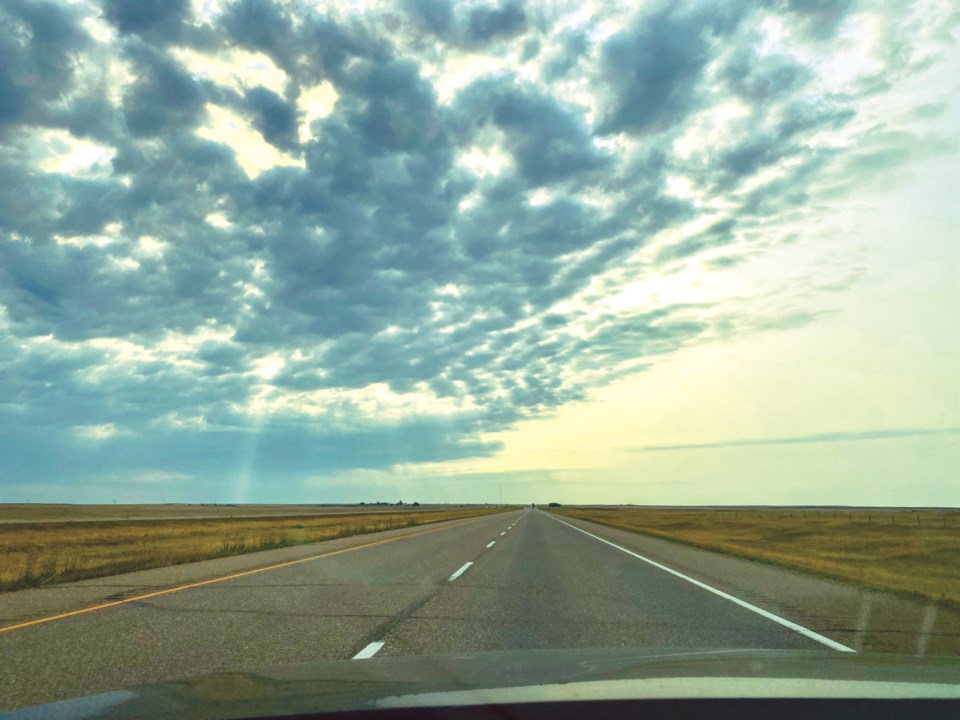As I write, I’m in the middle of a drive across Canada. If you’ve followed this column for more than five years, you’ll know it’s something I do on the regular. Having missed out since 2019, I practically leapt at the excuse of a Toronto wedding and a few days canoeing Northern Ontario on the return to pack up my car and head toward the sunrise. This kind of thing is inexplicable to most people I know who’ve made the haul. Why would you want to do that… again?
Reasonable question. And I’ll admit that piloting a car for 12 to 16 hours a day isn’t for everyone. Certainly, having a location-free job without regular hours makes such things easier. But like I said, I also genuinely enjoy the drive. It’s space to listen to books I’ve wanted to read, and think about my own book projects—all to a familiar and comforting visual leitmotif. I also prefer driving to the annoyances of flying—now more than ever.
If I’m in a hurry to get East, it’s a four-very-long-day affair: Whistler to Chestermere, Alta. (Medicine Hat if I’m really hustling); from Alberta to Kenora, Ont., (a loooong day crossing the entire Prairies and losing an hour to boot); then Kenora to Sault Ste. Marie, or as far as you can get (northern Ontario is always the wildcard for weather and other delays); then the Sault to Toronto (I try to arrive on a weekend to avoid rush hour). I tend to do the return journey in early fall to catch the colours and might add an extra day. In any event, I have it down to an art—the waypoints to clock, strategic gas stations, food options, places for a swim, motels, camping, whatever’s needed. Plus, the memories accompanying me, which come in two types—historical and personal.
Historical call-backs comprise a way to reconnect to this great, albeit flawed country. The Trans-Canada Highway links many of the important geographical places and events learned about in school—from Voyageur transit points to the Red River Rebellion, from the end of Terry Fox’s Marathon of Hope to the Last Spike in the critical transcontinental railroad. The mythical landforms and landscapes that filled your mind as a kid also play a part: Rogers Pass, Banff and the Rockies; the Prairies, with their quintessential flat-as-a-pancake expanses cut through by river valleys and rolling hills under huge skies; the sudden transition to aspen parkland then boreal forest in eastern Manitoba; northern Ontario’s seemingly interminable wilderness; the Sleeping Giant and red rocks of Thunder Bay; Georgian Bay’s 30,000 islands; and the skyline of Toronto (…something you’ll get onto/though they say you’ve got to live there for a while, wrote Gordon Lightfoot in his classic, “Alberta Bound”).
Personal memories are equally redolent, but the ones I go back to most are from my first ever cross-country foray as a wide-eyed teenager. The summer between Grade 12 and 13, myself, my brother and a mutual friend took a strange job delivering new cars from Toronto to Alberta for some executive, then driving the trade-ins back. I never understood why this made any sense—or why they’d hire three newly licensed teens—and in hindsight I’m sure there must have been some kind of scam underway. Whatever the reason, I learned to love and excel at the long-distance drive, becoming attuned to a country which, to that point, existed for me only in textbooks and National Film Board joints.
In the early 1970s, the Trans-Canada Highway was still a celebration, a concrete bow typing up a generational present, and looked and behaved in kind, delivering the country’s diversity and regional pride like a slow film. Indeed, once you passed Barrie, Ont., you were on an intimate two-lane all the way to Vancouver. In those days, there was no bypass for Winnipeg, Regina or Calgary—you drove straight through, which, given traffic and lights, could easily cost an hour at certain times of day. Although these pinch points have been scoured for through-driving efficiency, I fondly recall being introduced to each city for the first time and taking its pulse—lured into a “social” in Winnipeg by roadside signs, or spontaneously buying cowboy hats at a Calgary western outfitter. Such serendipity can’t be relived today even without bypasses due to the homogenous mall-and-franchise landscape (“McDonaldization,” so to speak) following the old routes in and out of cities.
It’s sadder to see some of the other changes the years have wrought—the lack of animals (those first drives were awash in moose, bear, pronghorns and Prairie dogs rarely seen today), and the abandoned mom-and-pop restaurants and motels of yore, now boarded up, covered in graffiti, burned or all three. In Rossport on legendary Lake Superior, my favourite spot to listen to loons and contemplate the legends of Gitche Gumee, the sloping, glacier-scoured pink granite of the Canadian Shield has been besmirched by painted messages—an inexplicable lack of appreciation for and affront against nature—the worst kind of vandalism and something that makes me feel very old indeed.
Fortunately, some things haven’t changed. I’ll never forget some of those first geographical watersheds—the serrations of the Rockies rising like a mirage on a distant Prairie horizon, or rounding the spectacular Lakehead during sunrise—because they still happen much as they originally did. Letting such visages sink deep into my psyche to settle with kindred moments vanquishes any scintilla of inexplicability about why I love this drive.
Leslie Anthony is a biologist, writer and author of several popular books on environmental science.




